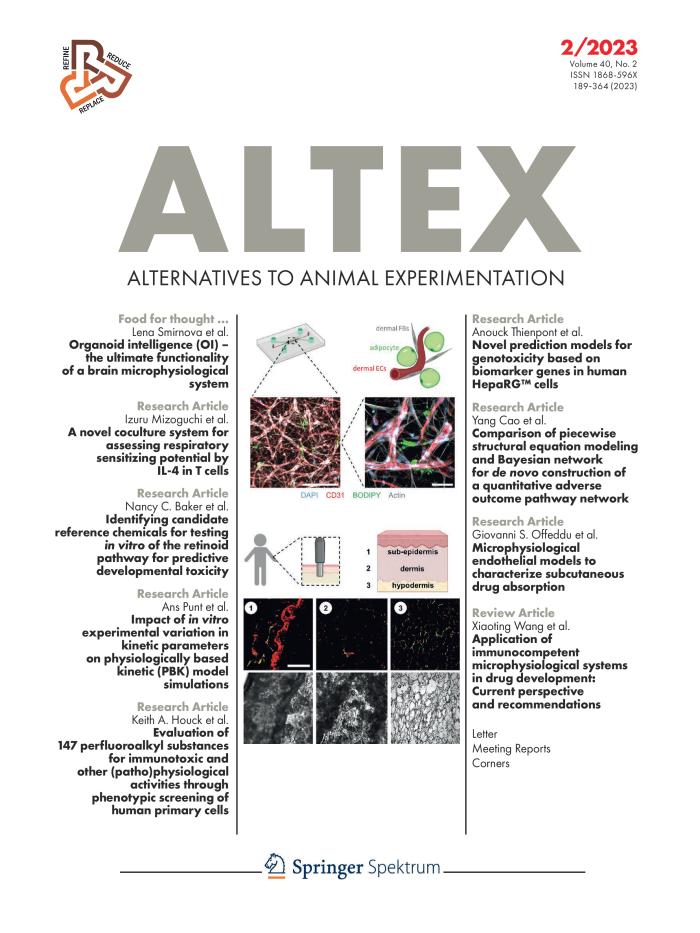Workshop report on the evaluation of the updated and expanded carcinogen database to support derivation of threshold of toxicological concern values for DNA-reactive carcinogens
Main Article Content
Article Details

This work is licensed under a Creative Commons Attribution 4.0 International License.
Articles are distributed under the terms of the Creative Commons Attribution 4.0 International license (http://creativecommons.org/licenses/by/4.0/), which permits unrestricted use, distribution and reproduction in any medium, provided the original work is appropriately cited (CC-BY). Copyright on any article in ALTEX is retained by the author(s).
Batke, M., Afrapoli, F. M., Kellner, R. et al. (2021). Threshold of toxicological concern – An update for non-genotoxic carcinogens. Front Toxicol 3, 688321. doi:10.3389/ftox.2021.688321
Boobis, A., Brown, P., Cronin, M. T. D. et al. (2017). Origin of the TTC values for compounds that are genotoxic and/or carcinogenic and an approach for their re-evaluation. Crit Rev Toxicol 47, 705-727. doi:10.1080/10408444.2017.1318822
Cheeseman, M., Machuga, E. and Bailey, A. (1999). A tiered approach to threshold of regulation. Food Chem Toxicol 37, 387-412. doi:10.1016/s0278-6915(99)00024-1
Cramer, G. M., Ford, R. A. and Hall, R. L. (1976). Estimation of toxic hazard – A decision tree approach. Food Cosmet Toxicol 16, 255-276. doi:10.1016/S0015-6264(76)80522-6
Cross, K. P. and Ponting, D. J. (2021). Developing structure-activity relationships for N-nitrosamine activity. Comput Toxicol 20, 100186. doi:10.1016/j.comtox.2021.100186
EFSA (2009). Guidance of the Scientific Committee on Use of the benchmark dose approach in risk assessment. EFSA J 7, 1150. doi:10.2903/j.efsa.2009.1150
EFSA (2012). Scientific opinion on exploring options for providing advice about possible human health risks based on the concept of threshold of toxicological concern (TTC). EFSA J 10, 2750. doi:10.2903/j.efsa.2012.2750
EFSA Scientific Committee, Hardy, A., Benford, D. et al. (2017). Update: Guidance on the use of the benchmark dose approach in risk assessment. EFSA J 15, 4658. doi:10.2903/j.efsa.2017.4658
EFSA Scientific Committee, More, S. J., Bampidis, V. et al. (2019). Guidance on the use of the threshold of toxicological concern approach in food safety assessment. EFSA J 17, e05708. doi:10.2903/j.efsa.2019.5708
EFSA and WHO (2016). Review of the threshold of toxicological concern (TTC) approach and development of new TTC decision tree. EFSA supporting publication. doi:10.2903/sp.efsa.2016.EN-1006
Ellison, C. A., Api, A. M., Becker, R. A. et al. (2020). Internal threshold of toxicological concern (iTTC): Where we are today and what is possible in the near future. Front Toxicol 2, 621541. doi:10.3389/ftox.2020.621541
Hardy, A., Benford, D., Halldorsson, T. et al. (2017). Update: Use of the benchmark dose approach in risk assessment. EFSA J 15, e04658. doi:10.2903/j.efsa.2017.4658
Kobets, T. and Williams, G. M. (2019). Review of the evidence for thresholds for DNA-reactive and epigenetic experimental chemical carcinogens. Chem Biol Interact 301, 88-111. doi:10.1016/j.cbi.2018.11.011
Kroes, R., Renwick, A. G., Cheeseman, M. et al. (2004). Structure-based thresholds of toxicological concern (TTC): Guidance for application to substances present at low levels in the diet. Food Chem Toxicol 42, 65-83. doi:10.1016/j.fct.2003.08.006
Munro, I. C., Ford, R. A., Kennepohl, E. et al. (1996). Correlation of structural class with no-observed-effect levels: A proposal for establishing a threshold of concern. Food Chem Toxicol 34, 829-867. doi:10.1016/S0278-6915(96)00049-X
Preston, R. J. and Williams, G. M. (2005). DNA-reactive carcinogens: Mode of action and human cancer hazard. Crit Rev Toxicol 35, 673-683. doi:10.1080/10408440591007278
Russell, W. M. S. (1999). The Principles of Humane Experimental Technique. Special edition. Wheathampstead: Universities Federation for Animal Welfare. ISBN0900767782.
WHO (2020). Principles and Methods for the Risk Assessment of Chemicals in Food (section 4.5). 2nd edition. Geneva, Switzerland: World Health Organization. ISBN9789241572408.


